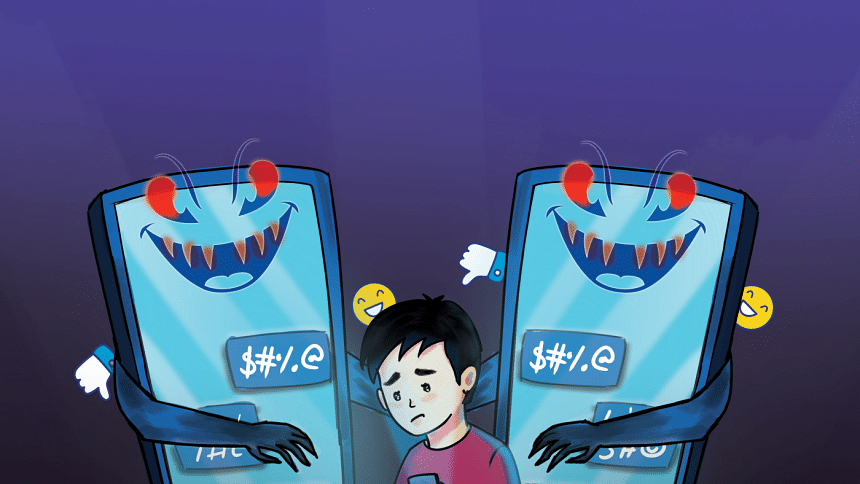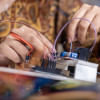The harrowing realities of cyberbullying

"I don't want to do anything, and make it worse. I'm scared they are going to troll me using my photos online," says Shadman Fahim*, a middle school student at a private school in Dhaka while sharing the ordeals of navigating the online space as a child. Classmates repeatedly target him by adding him to group chats where he faces relentless name-calling. However, he doesn't think to share it with a trusted adult, and believes it's only going to make it worse.
Cyberbullying is defined by the UNICEF as the use of digital technologies, like social media and messaging platforms, to repeatedly scare, anger, or shame targets. This includes spreading lies or posting sensitive or private photos online, sending hurtful messages or threats via messaging apps, and impersonating others to send malicious messages.
According to research by Kids Helpline Australia, cyberbullying most frequently occurs during the transition from primary to high school, although it continues throughout the teenage years. This particular group of young people is the most vulnerable to cyberbullying due to their internet exposure at an early age, and lack of digital literacy.
Labiba Raida, a 22-year-old student studying at North South University recounts that the first time she experienced cyberbullying was during her high school years. She describes how her bullying ordeal initially started at school, involving isolation, name-calling, body-shaming, and rumours, which then extended online.
"Honestly, I was so naive that I didn't even comprehend it as bullying," Labiba reflects.
Most young people may not recognise cyberbullying right away because it often becomes normalised in their peer groups, leading them to downplay or dismiss harmful actions and making them more vulnerable to its negative effects on their emotional well-being.
Nushrat Jahan*, a second-year student at BRAC University, shares the multiple accounts of cyber-bullying she faced during her high-school years. "There was a girl who used to stalk me on social media using fake accounts. She would send me hateful and triggering messages."
This was just one of the varying levels of cyber-bullying she faced. She further shares how a person she had met online targeted her by creating defamatory posts online.
"He reached out to my therapist and harassed them to share sensitive details about me. This happened during my last year of high-school."
Both Nushrat and Labiba are now adults, but their teenage experiences have left lasting marks on them. Even though they can now better articulate their situation, they are still recovering from their past experiences. At the time, they felt like they could never cope with the situation.
"Back then, it felt like it was the end of everything. Looking back, it wasn't the end of the world. But that doesn't change the fact that it was the worst time of my life," shares Nushrat.
One of the most common challenges young people face with cyberbullying is that they often don't recognise it immediately. Navigating the online space at such a young age is tricky, especially since schools don't typically teach online safety or digital literacy. As a result, they are not equipped to handle these situations, putting their well-being at risk.
They often recognise the situation and the threats once they become adults, as they are better equipped to identify such issues and seek help or report them.
"The most common emotional and mental effects on teenagers include issues with self-confidence, self-esteem, depression, social anxiety, self-harming behaviour, suicidal ideation, and feelings of hopelessness. These conditions often lead to a drastic decrease in self-worth, increasing the risk of social isolation and loneliness. Cyberbullying also significantly impacts academic performance," explains Mehrin Mostafa, a Psychological Counselor at the International University of Business Agriculture and Technology.
Mehrin Mostafa further shares, "Victims often engage in self-criticism, which perpetuates a cycle of shame, further eroding their self-worth and confidence."
Labiba shares how the bullying affected her mentally, and her performance at school. "I mostly stopped going to school, and my grades suffered a lot. I started dissociating during exams, and I would unknowingly leave a lot of answers blank. I completely isolated myself at school, and even on social media."
"I didn't pick up a book for two months after this incident. I isolated myself from everyone in my social circle. I deactivated all my social media accounts for two years, and got rid of all my devices except for my laptop, which I used for online classes," shares Nushrat.
"I am currently in therapy and I have been diagnosed with generalised anxiety disorder. That's how I finally recognised [the experience of] bullying," explains Labiba.
Nushrat further shares how having a supportive network of parents and teachers helped, elaborating, "I failed a lot of my mocks. At the end of the day, I am very grateful to have had teachers who helped me bounce back."
However, Labiba experienced a different situation where she felt her teachers had singled her out. "Even my teachers had cornered me because they thought I was a troubled child," she explains.
In this regard, Mehrin Mostafa emphasises the importance of communication in such situations, be it between parents, educators, or others.
In cases of cyberbullying, victims often struggle to report incidents to their schools due to the absence of effective support frameworks for cyberbullying victims. They fear their experiences will not be validated. Young people may also hesitate to confide in their parents, fearing potential negative repercussions that could exacerbate their situation.
"Every school or educational institute should establish an anti-bullying committee comprising administrators, teachers, educators, parents, and a mental health professional to ensure a significant and consistent impact. Additionally, it may be more beneficial if both perpetrators and victims avoid group treatments or interventions, as these could potentially exacerbate the damaging effects," advises Mehrin Mostafa on institutional support.
She adds, "By informing them about what cyberbullying is, how to recognise it, and where to seek help, we can make a significant impact. It's essential to emphasise that seeking help is not shameful."
Reporting incidents of cyberbullying is crucial in addressing the issue. However, many cases go overlooked since social media platforms fall outside a school's jurisdiction, and parents often miss the issue due to their own lack of digital literacy. This places the responsibility on social media companies to ensure a safe environment. Unfortunately, current regulations may prove to be insufficient, as cyberbullying continues to occur.
We now live in a digital world where an increasing number of young people are growing up deeply immersed in online environments. However, most lack the knowledge to navigate the internet safely and possess limited digital literacy skills at an early age, putting them at risk as they socialise more online.
While cyberbullying does not cause physical harm like traditional bullying, it has a profound mental impact on its victims, with some effects lasting into adulthood. Despite its virtual nature, cyberbullying has tangible real-world consequences, making it crucial to implement effective measures to protect these young individuals.
*Names have been changed due to privacy
Reference:
1. UNICEF. Cyberbullying: What is it and how to stop it.

 For all latest news, follow The Daily Star's Google News channel.
For all latest news, follow The Daily Star's Google News channel. 








Comments